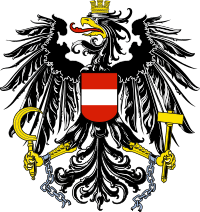Coat of arms of Austria facts for kids
Quick facts for kids Coat of arms of Austria |
|
|---|---|
 |
|
| Versions | |

First Republic, 1919–1934
|
|

Federal State ("Corporate" State) 1934–1938
|
|
| Armiger | Republic of Austria |
| Adopted | 1945 |
| Crest | A mural crown Or |
| Blazon | Gules, a fess argent (arms of the Duchy of Austria, flag of Austria) |
| Supporters | An eagle sable gambed Or displayed |
| Other elements | The eagle bears a sickle Or in dexter talon and a hammer Or in sinister talon. The gambs also bear broken iron chains. |
| Earlier version(s) | As current version but without broken chains (1919–1934), Imperial-style double headed eagle (1934–1938) |
The current coat of arms of Austria has been in use by the Republic of Austria since 1919. Between 1934 and the 1938 Austria used a different coat of arms. It had a double-headed eagle. In 1945 the original coat of arms returned, with broken chains added to show Austria's freedom.
Symbolism
The symbols and emblems used in the Austrian arms are as follows:
- The Eagle: Austria's freedom (introduced 1919)
- The escutcheon Emblem of Austria (late Middle Ages, reintroduced 1915)
- The mural crown: The middle class (introduced 1919)
- The sickle: Agriculture (introduced 1919)
- The Hammer: Industry (introduced 1919)
- The broken chains: Freedom from National Socialist dictatorship (added 1945)
See also
 In Spanish: Escudo de Austria para niños
In Spanish: Escudo de Austria para niños

All content from Kiddle encyclopedia articles (including the article images and facts) can be freely used under Attribution-ShareAlike license, unless stated otherwise. Cite this article:
Coat of arms of Austria Facts for Kids. Kiddle Encyclopedia.
